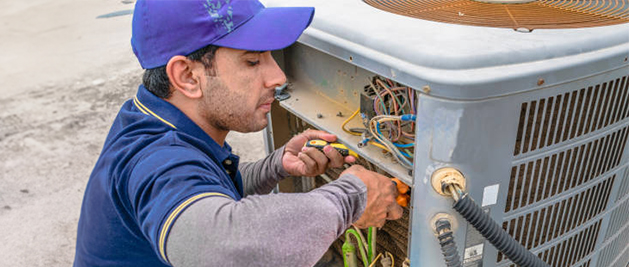TOP TIPS FOR AC REPLACEMENT
1. Choose local HVAC experts with a good reputation in your community.
Instead of choosing a contractor based on flashy ads or big discounts, prioritize a local, medium-sized company with a proven reputation in your community. Local companies often provide more personalized service and are vested in maintaining their reputation within the community. This means they are more likely to offer honest advice and reliable service.
2. Select the right SEER rating.
The SEER rating is a measure of how efficiently an air conditioner can cool your home over a typical cooling season. The higher the SEER, the more efficient the unit. Modern units typically have SEER ratings of 13-26, with higher numbers indicating better efficiency and energy savings.
For most homeowners, a SEER rating between 14 and 16 provides a good balance of energy efficiency and cost. Units within this range are more affordable and offer substantial energy savings compared to older, less efficient models. Compare the total costs of different units, including installation and maintenance, after considering any promotional offers. Ensure the model recommended fits your specific needs and is not just an upsell due to the discount. Homeowners should consider their budget, energy usage patterns, and how long they plan to stay in their home when choosing a SEER rating.
3. Get a proper assessment of your cooling needs.
Your home’s unique characteristics—size, insulation, window placement, and existing ductwork—should influence your AC system choice. A home comfort specialist will thoroughly inspect your home to identify any specific comfort-related issues that need addressing to ensure your new system will be both efficient and effective.
We will perform a Manual J load calculation to determine the precise cooling needs of your home. This calculation considers factors like square footage, insulation levels, and climate conditions, so your new system will be sized correctly for maximum efficiency and comfort.
THE AC INSTALLATION PROCESS

Installing a new air conditioner involves several critical steps to ensure proper operation, efficiency, and longevity.
1. Removing the Old Unit
If replacing an existing unit, our technician will disconnect and remove the old air conditioner. The old refrigerant is safely recovered to comply with environmental regulations. Electrical connections and refrigerant lines are carefully disconnected to prevent damage or leaks.
2. Preparing the Installation Site
The installation site is prepared to accommodate the new unit. Inspecting and possibly upgrading the existing ductwork to ensure it is compatible and efficient for the new system. We may place a new concrete pad if needed to provide a stable base for the outdoor unit, ensuring it is level and secure.
3. Installing the New Unit
The installation of the new air conditioner involves several steps: The new outdoor condenser unit is placed on the prepared pad, ensuring it has proper airflow and maintenance access clearance. The indoor evaporator coil is installed within the furnace or air handler for central air systems. Refrigerant lines are connected between the indoor and outdoor units. Electrical wiring is also connected to power the system and communicate between components.
4. Setting Up the Thermostat
Our technician will install and program a new thermostat if needed, ensuring it is compatible with the new system and configured for optimal performance.
5. System Testing and Calibration
After installation, we perform a series of tests to ensure the system operates correctly. We check refrigerant lines for leaks using a pressure test. All electrical connections are tested to ensure they are secure and functioning properly. We test airflow to confirm that it is within the recommended range for the system.
6. Final Inspection and Homeowner Education
A final inspection ensures everything is installed correctly. Our technician will then teach you how to operate the new system, including how to use the thermostat and perform basic maintenance. We will discuss the importance of regular maintenance and provide a recommended maintenance schedule. Provide all warranty information and ensure the homeowner understands the terms and how to maintain the warranty.
What Can You Do About Hot Spots?

Even the best central air systems sometimes struggle to keep every corner of your home comfortable. If you’ve ever walked into a second-story bedroom that’s hotter than the rest of the house, tried to cool a sunroom that bakes all afternoon, or added a new space that ductwork doesn’t reach, you may already know the limitations. Central AC works great for whole-home comfort in many situations but isn’t always a one-size-fits-all solution in homes with unique layouts, additions, or aging systems.
In certain scenarios, additional cooling options like a ductless mini split air conditioner might be the right add-on solution to support your central air system. Do any of the following locations stay uncomfortably warm no matter what you try with your thermostat settings? You might need more than central air alone.
Common Hot Spot Areas in the House
Upstairs Bedrooms
Warm air rises, and many two-story homes’ upstairs bedrooms stay warm in the summer no matter how low you program the thermostat. Your central system might work fine downstairs but can’t push enough cool air to balance temperatures upstairs.
Finished Basements or Bonus Rooms
If you’ve finished a basement or attic space, these areas often fall outside the original HVAC design. Running ductwork to them can be expensive or frequently impossible. Without a supplemental solution, these rooms usually stay uncomfortable year-round.
Sunrooms and Home Additions
Sunrooms, garage conversions, or recent additions typically have different insulation and exposure to the sun. As a result, your existing AC system might not be able to keep up.
Home Offices and Gyms
You might spend hours in a small home office or home gym, and that room needs more cooling than the rest of your home. Cranking the whole system just to cool one room doesn’t make sense, and it’s a fast way to drive up your energy bills.
Is Your Central AC System Aging or Overworked? Should You Get a Ductless Mini Split?
Even if your central air system still runs, it may no longer keep up with extreme summer heat, especially if it’s more than 10 years old. Rather than overworking it or rushing into a full replacement, you can support it with a more targeted solution.
What’s a Ductless Mini Split and How Does It Work?
Ductless mini splits are a simple and efficient way to cool specific areas of your home without replacing your central system or tearing into walls to add ductwork. Installation is usually quick and minimally disruptive, and you’ll feel a noticeable difference almost immediately.
Each mini split system includes an outdoor condenser unit and one or more compact indoor air handlers. A technician mounts these air handlers directly on a wall or ceiling, where they connect to the outdoor unit via small refrigerant lines. Inside each handler, the system pulls warm air from the room, passes it over chilled coils, and recirculates the cooled air back inside. The refrigerant carries heat to the outdoor unit, where it’s released, just like in traditional central AC.
Because there’s no ductwork, mini splits avoid the energy loss that often occurs with central systems and in older homes where ducts may leak or lack proper insulation. You also get independent temperature control for each zone. That means you can cool only the rooms you’re using, helping you save energy without sacrificing comfort.
